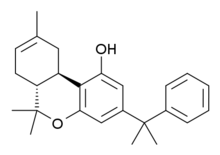KM-233
From Wikipedia, the free encyclopedia
 | |
|---|---|
| Systematic (IUPAC) name | |
| (−)-(6aR,7,10,10aR)-tetrahydro-6,6,9-trimethyl-3-(1-methyl-1-phenylethyl)-6H-dibenzo[b,d]pyran-1-ol | |
| Clinical data | |
| Legal status | ? |
| Identifiers | |
| CAS number | 628263-22-9 |
| ATC code | None |
| PubChem | CID 10248110 |
| Chemical data | |
| Formula | C25H30O2 |
| Mol. mass | 362.503 g/mol |
| SMILES
| |
KM-233 is a drug which is an analogue of Δ8-tetrahydrocannabinol (THC), the less active but more stable isomer of the active component of Cannabis. KM-233 differs from Δ8-THC by the pentyl sidechain being replaced by a 1,1-dimethylbenzyl group. It has high binding affinity in vitro for both the CB1 and CB2 receptors, with a CB2 affinity of 0.91nM and 13x selectivity over the CB1 receptor.[1] In animal studies it has been found to be effective for the treatment of glioma, a form of brain tumor.[2] A large number of related analogues are known where the 1,1-dimethylbenzyl group is substituted or replaced by other groups, with a fairly well established structure-activity relationship.[3][4][5][6][7]
See also
References
- ↑ Krishnamurthy M, Ferreira AM, Moore BM 2nd. Synthesis and testing of novel phenyl substituted side-chain analogues of classical cannabinoids. Bioorganic and Medicinal Chemistry Letters. 2003 Oct 20;13(20):3487-90. PMID 14505654
- ↑ Duntsch C, et al. Safety and efficacy of a novel cannabinoid chemotherapeutic, KM-233, for the treatment of high-grade glioma. Journal of Neuro-oncology. 2006 Apr;77(2):143-52. PMID 16314952
- ↑ Nadipuram AK, et al. Synthesis and testing of novel classical cannabinoids: exploring the side chain ligand binding pocket of the CB1 and CB2 receptors. Bioorganic and Medicinal Chemistry. 2003 Jul 17;11(14):3121-32. PMID 12818675
- ↑ Durdagi S, et al. The application of 3D-QSAR studies for novel cannabinoid ligands substituted at the C1' position of the alkyl side chain on the structural requirements for binding to cannabinoid receptors CB1 and CB2. Journal of Medicinal Chemistry. 2007 Jun 14;50(12):2875-85. PMID 17521177
- ↑ Krishnamurthy M, Gurley S, Moore BM 2nd. Exploring the substituent effects on a novel series of C1'-dimethyl-aryl Delta8-tetrahydrocannabinol analogs. Bioorganic and Medicinal Chemistry. 2008 Jul 1;16(13):6489-500. PMID 18524604
- ↑ Ferreira AM, et al. Quantitative structure-activity relationship (QSAR) for a series of novel cannabinoid derivatives using descriptors derived from semi-empirical quantum-chemical calculations. Bioorganic and Medicinal Chemistry. 2009 Mar 15;17(6):2598-606. PMID 19250829
- ↑ Brogi S, et al. Three-dimensional quantitative structure-selectivity relationships analysis guided rational design of a highly selective ligand for the cannabinoid receptor 2. European Journal of Medicinal Chemistry. 2011 Feb;46(2):547-55. PMID 21183257
This article is issued from Wikipedia. The text is available under the Creative Commons Attribution/Share Alike; additional terms may apply for the media files.